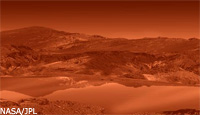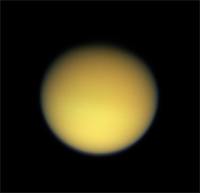Cassini confirms liquid surface on Titan
31 July 2008
Observations with the VIMS instrument on Cassini have identified the presence of liquid ethane in one of the large lake-like features observed on Saturn's moon, Titan. These results are reported by R. Brown and colleagues in the 31 July issue of Nature.
 |
|
An artist's concept illustrating a mirror-smooth lake on the surface of the smoggy moon Titan (NASA/JPL) |
 |
|
The smog-enshrouded moon Titan (NASA/JPL/Space Science Institute ) |
Ontario Lacus is a lake-like feature in the south-polar region of Titan first detected with the Cassini Imaging Science Subsystem in mid-2005. Brown and colleagues report on observations of this region that were made during the 38th close fly-by of Titan on 4 December 2007 with the Visual and Infrared Mapping Spectrometer (VIMS) onboard the Cassini Spacecraft.
Titan’s thick atmosphere makes study of its surface difficult except for specific atmospheric windows at 2.0, 2.7 and 5.0 µm. The VIMS instrument can penetrate the atmosphere through these windows to obtain, for example, measurements which are used to determine the chemical composition of the surface.
Infrared observations of Ontario Lacus yielded spectra with features which are indicative of the composition and nature of the contents of the lake. A characteristic ethane signature was observed in the VIMS spectra at 2.0 μm. Near 5.0 µm the spectra revealed a very steep decline in reflectance. The authors interpret these features as evidence of a lake filled with a quiescent liquid which is consistent with the presence of ethane. The ethane is probably in liquid solution with methane, nitrogen and other low-molecular-mass hydrocarbons.
Brown and colleagues have ruled out the presence of water ice, ammonia, ammonia hydrate and carbon dioxide in Ontario Lacus. The spectra of the lake that have been obtained by VIMS do not support the presence of these materials. In addition, all of these materials would be solid rather than liquid at the temperatures on the surface of Titan.
Prior to the Cassini mission it was widely believed that Titan would have global oceans of methane, ethane and other light hydrocarbons. The 45 close fly-bys of Titan, during the nominal Cassini mission, have shown that no such global oceans exist, but hundreds of dark, lake-like features are present. Until now, it was not known whether these features were liquid or simply dark, solid material. These new results provide firm evidence supporting the interpretation of these features as liquid lakes.
Titan is one of the primary targets of the Cassini Equinox Mission, the mission extension which began 30 June 2008. Data from the Cassini primary and extended missions are providing valuable data for future missions to Saturn, Titan and Enceladus.
"Ontario Lacus is a potential target for a lake lander under consideration for TandEM/TSSM, a possible future mission to Titan", according to Jean-Pierre Lebreton, ESA Project Scientist and Mission Manager for the Huygens mission, and Study scientist for TandEM/TSSM.
Related publication
Brown, R.H. et al., “The identification of liquid ethane in Titan’s Ontario Lacus”, Nature, Vol 454, 31 July 2008. DOI: 10.1038/nature07100
